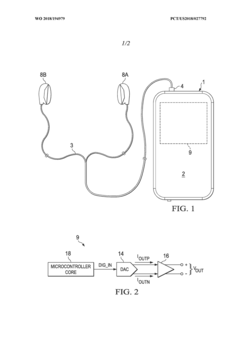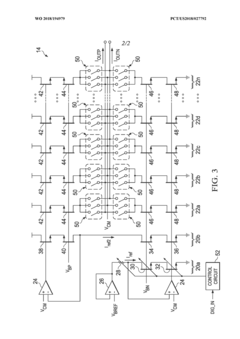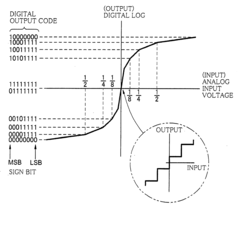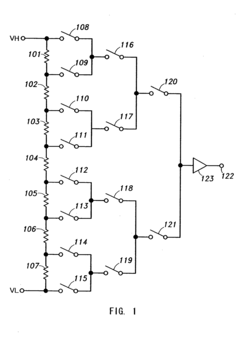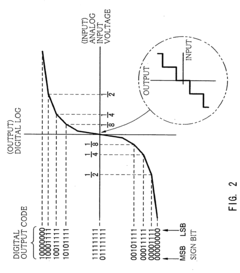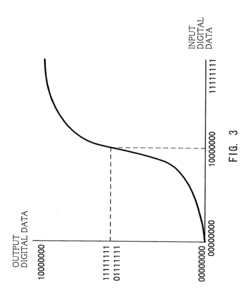Leveraging LDAC in Personal Entertainment Devices
JUL 4, 20259 MIN READ
Generate Your Research Report Instantly with AI Agent
Patsnap Eureka helps you evaluate technical feasibility & market potential.
LDAC Technology Evolution and Objectives
LDAC (Low Latency Audio Codec) technology has evolved significantly since its introduction by Sony in 2015. Initially developed to address the limitations of existing Bluetooth audio codecs, LDAC aimed to provide high-resolution audio transmission over Bluetooth connections. The primary objective was to deliver near CD-quality audio wirelessly, a feat that was challenging due to Bluetooth's bandwidth constraints.
The evolution of LDAC has been driven by the increasing demand for high-fidelity audio in personal entertainment devices. As consumers became more discerning about audio quality, there was a growing need for a codec that could transmit audio at higher bit rates while maintaining low latency. LDAC's development focused on achieving three key objectives: maximizing audio quality, minimizing latency, and ensuring compatibility with a wide range of devices.
Throughout its evolution, LDAC has undergone several iterations to improve its performance. The codec now supports multiple transmission modes, allowing for adaptive bit rates depending on the connection quality and device capabilities. This flexibility enables LDAC to maintain optimal audio quality across various scenarios, from ideal conditions to more challenging environments with potential interference.
One of the significant milestones in LDAC's evolution was its adoption by the Android Open Source Project (AOSP) in 2017. This integration made LDAC available to a broader range of devices and manufacturers, expanding its reach beyond Sony's ecosystem. The move also aligned with the growing trend of high-resolution audio support in smartphones and other portable devices.
The technical objectives of LDAC have expanded over time. While the initial focus was on audio quality, subsequent developments have aimed to improve energy efficiency, reduce processing overhead, and enhance compatibility with emerging Bluetooth standards. These objectives reflect the changing landscape of personal entertainment devices, where battery life and seamless connectivity are as crucial as audio fidelity.
Looking forward, the evolution of LDAC is likely to continue in several directions. There is an ongoing effort to further reduce latency, which is particularly important for gaming and virtual reality applications. Additionally, as new audio formats and immersive sound technologies emerge, LDAC may need to adapt to support these advancements while maintaining its core strengths in high-resolution audio transmission.
The future objectives for LDAC technology in personal entertainment devices include seamless integration with smart home ecosystems, improved multi-device connectivity, and enhanced support for spatial audio formats. As the boundaries between different types of personal entertainment devices blur, LDAC's evolution will likely focus on providing a unified, high-quality audio experience across a diverse range of products and use cases.
The evolution of LDAC has been driven by the increasing demand for high-fidelity audio in personal entertainment devices. As consumers became more discerning about audio quality, there was a growing need for a codec that could transmit audio at higher bit rates while maintaining low latency. LDAC's development focused on achieving three key objectives: maximizing audio quality, minimizing latency, and ensuring compatibility with a wide range of devices.
Throughout its evolution, LDAC has undergone several iterations to improve its performance. The codec now supports multiple transmission modes, allowing for adaptive bit rates depending on the connection quality and device capabilities. This flexibility enables LDAC to maintain optimal audio quality across various scenarios, from ideal conditions to more challenging environments with potential interference.
One of the significant milestones in LDAC's evolution was its adoption by the Android Open Source Project (AOSP) in 2017. This integration made LDAC available to a broader range of devices and manufacturers, expanding its reach beyond Sony's ecosystem. The move also aligned with the growing trend of high-resolution audio support in smartphones and other portable devices.
The technical objectives of LDAC have expanded over time. While the initial focus was on audio quality, subsequent developments have aimed to improve energy efficiency, reduce processing overhead, and enhance compatibility with emerging Bluetooth standards. These objectives reflect the changing landscape of personal entertainment devices, where battery life and seamless connectivity are as crucial as audio fidelity.
Looking forward, the evolution of LDAC is likely to continue in several directions. There is an ongoing effort to further reduce latency, which is particularly important for gaming and virtual reality applications. Additionally, as new audio formats and immersive sound technologies emerge, LDAC may need to adapt to support these advancements while maintaining its core strengths in high-resolution audio transmission.
The future objectives for LDAC technology in personal entertainment devices include seamless integration with smart home ecosystems, improved multi-device connectivity, and enhanced support for spatial audio formats. As the boundaries between different types of personal entertainment devices blur, LDAC's evolution will likely focus on providing a unified, high-quality audio experience across a diverse range of products and use cases.
Market Demand for High-Quality Audio Streaming
The demand for high-quality audio streaming in personal entertainment devices has been steadily increasing over the past decade. This trend is driven by several factors, including the growing popularity of music streaming services, the rise of high-resolution audio formats, and the increasing consumer expectations for superior sound quality.
Music streaming platforms have become the primary mode of music consumption for many users worldwide. As these services continue to expand their user base, there is a corresponding increase in demand for better audio quality. Consumers are becoming more discerning about the audio experience, seeking to replicate the richness and depth of studio-quality sound in their personal devices.
The advent of high-resolution audio formats has further fueled this demand. Formats such as FLAC, DSD, and MQA offer significantly better audio quality compared to traditional compressed formats like MP3. As awareness of these formats grows, consumers are increasingly seeking devices that can support and deliver this enhanced audio experience.
Personal entertainment devices, including smartphones, tablets, and portable music players, are at the forefront of this market demand. Manufacturers are under pressure to incorporate advanced audio technologies to meet consumer expectations. This has led to a surge in interest for technologies like LDAC, which can transmit high-resolution audio wirelessly without significant quality loss.
The automotive industry has also recognized this trend, with car manufacturers integrating high-quality audio systems as a key selling point. This expansion of the market beyond personal devices indicates the breadth of demand for superior audio streaming capabilities.
Market research indicates that the global high-resolution audio market is experiencing substantial growth. Factors contributing to this growth include increasing disposable income, growing awareness of audio quality, and the proliferation of high-end audio equipment.
However, challenges remain in meeting this demand. Issues such as compatibility between devices, the need for specialized hardware, and the higher costs associated with high-quality audio technologies can be barriers to widespread adoption. Despite these challenges, the overall trend suggests a continued strong demand for high-quality audio streaming in personal entertainment devices.
As technology continues to advance and become more accessible, it is likely that the demand for high-quality audio streaming will further intensify. This presents significant opportunities for companies developing technologies like LDAC to capture market share and drive innovation in the personal entertainment device sector.
Music streaming platforms have become the primary mode of music consumption for many users worldwide. As these services continue to expand their user base, there is a corresponding increase in demand for better audio quality. Consumers are becoming more discerning about the audio experience, seeking to replicate the richness and depth of studio-quality sound in their personal devices.
The advent of high-resolution audio formats has further fueled this demand. Formats such as FLAC, DSD, and MQA offer significantly better audio quality compared to traditional compressed formats like MP3. As awareness of these formats grows, consumers are increasingly seeking devices that can support and deliver this enhanced audio experience.
Personal entertainment devices, including smartphones, tablets, and portable music players, are at the forefront of this market demand. Manufacturers are under pressure to incorporate advanced audio technologies to meet consumer expectations. This has led to a surge in interest for technologies like LDAC, which can transmit high-resolution audio wirelessly without significant quality loss.
The automotive industry has also recognized this trend, with car manufacturers integrating high-quality audio systems as a key selling point. This expansion of the market beyond personal devices indicates the breadth of demand for superior audio streaming capabilities.
Market research indicates that the global high-resolution audio market is experiencing substantial growth. Factors contributing to this growth include increasing disposable income, growing awareness of audio quality, and the proliferation of high-end audio equipment.
However, challenges remain in meeting this demand. Issues such as compatibility between devices, the need for specialized hardware, and the higher costs associated with high-quality audio technologies can be barriers to widespread adoption. Despite these challenges, the overall trend suggests a continued strong demand for high-quality audio streaming in personal entertainment devices.
As technology continues to advance and become more accessible, it is likely that the demand for high-quality audio streaming will further intensify. This presents significant opportunities for companies developing technologies like LDAC to capture market share and drive innovation in the personal entertainment device sector.
LDAC Implementation Challenges
LDAC implementation in personal entertainment devices presents several significant challenges that manufacturers and developers must address. One of the primary obstacles is the high computational requirements of LDAC encoding and decoding processes. The codec's complex algorithms demand substantial processing power, which can strain the limited resources of portable devices, potentially leading to increased power consumption and reduced battery life.
Another critical challenge lies in maintaining consistent audio quality across various network conditions. LDAC's adaptive bitrate feature, while beneficial, requires sophisticated algorithms to seamlessly switch between different quality modes without introducing audible artifacts or interruptions in playback. This becomes particularly challenging in mobile scenarios where network stability can fluctuate rapidly.
Compatibility issues also pose a significant hurdle in LDAC implementation. Not all devices support LDAC natively, necessitating the development of fallback mechanisms to ensure seamless audio playback across a wide range of devices and platforms. This compatibility challenge extends to older Bluetooth versions and non-LDAC enabled devices, requiring manufacturers to implement robust codec negotiation protocols.
Latency management is another crucial aspect that developers must address. While LDAC offers high-quality audio transmission, it can introduce additional latency compared to standard Bluetooth codecs. This latency can be particularly problematic in applications requiring precise audio-video synchronization, such as gaming or video playback on personal entertainment devices.
Furthermore, the integration of LDAC with existing audio processing chains in personal devices presents its own set of challenges. Manufacturers must carefully optimize the audio signal path to preserve the high-quality output of LDAC while accommodating device-specific audio enhancements and equalization features. This often requires a delicate balance between maintaining LDAC's fidelity and implementing device-specific sound signatures.
Lastly, the licensing and certification process for LDAC implementation can be complex and time-consuming. Manufacturers must navigate Sony's licensing requirements and undergo rigorous testing to ensure their implementations meet the required standards. This process can impact development timelines and increase the overall cost of product development for personal entertainment devices incorporating LDAC technology.
Another critical challenge lies in maintaining consistent audio quality across various network conditions. LDAC's adaptive bitrate feature, while beneficial, requires sophisticated algorithms to seamlessly switch between different quality modes without introducing audible artifacts or interruptions in playback. This becomes particularly challenging in mobile scenarios where network stability can fluctuate rapidly.
Compatibility issues also pose a significant hurdle in LDAC implementation. Not all devices support LDAC natively, necessitating the development of fallback mechanisms to ensure seamless audio playback across a wide range of devices and platforms. This compatibility challenge extends to older Bluetooth versions and non-LDAC enabled devices, requiring manufacturers to implement robust codec negotiation protocols.
Latency management is another crucial aspect that developers must address. While LDAC offers high-quality audio transmission, it can introduce additional latency compared to standard Bluetooth codecs. This latency can be particularly problematic in applications requiring precise audio-video synchronization, such as gaming or video playback on personal entertainment devices.
Furthermore, the integration of LDAC with existing audio processing chains in personal devices presents its own set of challenges. Manufacturers must carefully optimize the audio signal path to preserve the high-quality output of LDAC while accommodating device-specific audio enhancements and equalization features. This often requires a delicate balance between maintaining LDAC's fidelity and implementing device-specific sound signatures.
Lastly, the licensing and certification process for LDAC implementation can be complex and time-consuming. Manufacturers must navigate Sony's licensing requirements and undergo rigorous testing to ensure their implementations meet the required standards. This process can impact development timelines and increase the overall cost of product development for personal entertainment devices incorporating LDAC technology.
Current LDAC Integration Solutions
01 LDAC audio codec implementation
LDAC is a high-quality audio codec developed for Bluetooth audio transmission. It allows for efficient encoding and decoding of audio data, providing high-resolution audio playback over wireless connections. The codec is designed to maintain audio quality while optimizing bandwidth usage.- LDAC audio codec implementation: LDAC is a high-quality audio codec developed for Bluetooth audio transmission. It allows for efficient encoding and decoding of audio data, providing high-resolution audio playback over wireless connections. The codec is designed to maintain audio quality while optimizing bandwidth usage.
- LDAC integration in audio devices: Various audio devices, including smartphones, headphones, and speakers, incorporate LDAC technology to enhance wireless audio transmission. These devices utilize LDAC encoding and decoding capabilities to provide users with high-quality audio experiences over Bluetooth connections.
- LDAC in automotive audio systems: LDAC technology is being integrated into automotive audio systems to improve in-car entertainment experiences. This implementation allows for high-quality audio streaming from mobile devices to car audio systems, enhancing the overall audio performance in vehicles.
- LDAC compatibility with other audio technologies: Efforts are being made to ensure LDAC compatibility with various audio technologies and standards. This includes integration with different audio processing systems, codecs, and wireless communication protocols to provide seamless audio experiences across different devices and platforms.
- LDAC optimization for power efficiency: Research and development are focused on optimizing LDAC technology for improved power efficiency in battery-operated devices. This involves refining the encoding and decoding processes to reduce power consumption while maintaining high audio quality, particularly in portable audio devices.
02 LDAC integration in audio devices
Various audio devices, including smartphones, headphones, and speakers, incorporate LDAC technology to enhance wireless audio transmission. These devices utilize LDAC encoding and decoding capabilities to provide users with high-quality audio experiences over Bluetooth connections.Expand Specific Solutions03 LDAC in automotive audio systems
LDAC technology is being integrated into automotive audio systems to improve in-car entertainment experiences. This implementation allows for high-quality audio streaming from mobile devices to car audio systems, enhancing the overall audio performance in vehicles.Expand Specific Solutions04 LDAC compatibility with other audio technologies
LDAC is designed to be compatible with various audio technologies and standards. This includes integration with other audio codecs, digital signal processing techniques, and audio enhancement algorithms to provide a comprehensive audio solution for different applications and devices.Expand Specific Solutions05 LDAC in wireless audio transmission systems
LDAC is utilized in wireless audio transmission systems to achieve high-quality audio streaming. These systems employ LDAC encoding and decoding processes to maintain audio fidelity while efficiently transmitting data over wireless networks, catering to various applications such as home audio systems and professional audio equipment.Expand Specific Solutions
Key Players in LDAC Ecosystem
The LDAC technology in personal entertainment devices is currently in a growth phase, with increasing market adoption and expanding applications. The market size for LDAC-enabled devices is steadily growing, driven by consumer demand for high-quality wireless audio experiences. Technologically, LDAC is relatively mature, with major players like Sony, Apple, and Samsung incorporating it into their products. However, there is still room for innovation and improvement in areas such as power efficiency and compatibility. The competitive landscape is dominated by established electronics giants, with Sony leading the pack as the technology's developer, while other companies like Qualcomm and MediaTek are also making significant strides in this space.
Sony Group Corp.
Technical Solution: Sony, as the creator of LDAC technology, has implemented it extensively in their personal entertainment devices. Their approach involves using a proprietary codec that can transmit audio data at up to 990 kbps, which is about three times the data transmitted by conventional Bluetooth audio[1]. Sony's LDAC technology employs adaptive bit rate to optimize audio quality based on wireless connection stability, ensuring high-quality audio even in challenging environments[2]. The company has also integrated LDAC into their BRAVIA TVs, allowing for high-quality wireless audio transmission to compatible headphones and speakers[3].
Strengths: Superior audio quality, wide compatibility with various devices, adaptive performance. Weaknesses: Proprietary technology, potential licensing costs for other manufacturers.
Samsung Electronics Co., Ltd.
Technical Solution: Samsung has embraced LDAC technology in their Galaxy series smartphones and tablets, allowing users to experience high-quality audio with compatible devices. They have also developed their own Scalable Codec, which dynamically adjusts the bit-rate between 88kbps and 512kbps to maintain stable connectivity[6]. Samsung's approach involves integrating multiple high-quality codecs, including LDAC, aptX, and AAC, into their devices to ensure broad compatibility and optimal audio experiences across various scenarios[7].
Strengths: Wide codec support, including LDAC, ensuring compatibility with various devices. Weaknesses: Reliance on third-party technologies for highest quality audio transmission.
LDAC Core Technical Innovations
Fully-differential current digital-to-analog converter
PatentWO2018194979A1
Innovation
- A fully-differential current-mode digital-to-analog converter with a control circuit that dynamically scales current mirror ratios between reference elements and current-mode DAC elements based on the input signal characteristics, allowing selective enabling and disabling of current-mode DAC elements, and using current mirrors with scaled reference currents to optimize noise reduction and power efficiency.
D/A converter for a digital signal after non-linear A/D conversion, audio signal processing circuit and liquid crystal display device including the same
PatentInactiveUS20050128112A1
Innovation
- A resistor string type D/A converter with weighted resistor values that directly converts non-linear digital signals into analog signals without the need for a decode circuit, allowing for a more compact and cost-effective design.
LDAC Compatibility and Interoperability
LDAC compatibility and interoperability are crucial factors in the widespread adoption and success of this high-resolution audio codec in personal entertainment devices. As LDAC technology continues to evolve, ensuring seamless integration across various platforms and devices becomes increasingly important.
One of the primary challenges in LDAC compatibility is the need for both the transmitting and receiving devices to support the codec. While Sony, the developer of LDAC, has made significant strides in licensing the technology to other manufacturers, there is still a gap in universal adoption. This limitation can create frustration for consumers who may find that their high-end audio devices are not fully compatible with their smartphones or other portable media players.
To address this issue, many device manufacturers are now incorporating LDAC support into their products. Android devices, in particular, have seen widespread integration of LDAC since version 8.0 (Oreo), which has greatly expanded the ecosystem of compatible devices. However, notable exceptions remain, such as Apple products, which currently do not support LDAC.
Interoperability between different versions of LDAC is another important consideration. As the codec evolves and improves, ensuring backward compatibility becomes essential to maintain a consistent user experience across different generations of devices. Sony has been proactive in this regard, ensuring that newer implementations of LDAC can still communicate effectively with older versions, albeit potentially at lower quality settings.
The integration of LDAC with other audio technologies and standards also plays a crucial role in its compatibility landscape. For instance, its interaction with Bluetooth audio standards, such as A2DP (Advanced Audio Distribution Profile), is vital for ensuring broad device support. LDAC's ability to operate at different bit rates (330 kbps, 660 kbps, and 990 kbps) also contributes to its flexibility in various usage scenarios and device capabilities.
Furthermore, the implementation of LDAC in chipsets and system-on-chip (SoC) solutions is key to expanding its compatibility. As more semiconductor manufacturers incorporate LDAC support into their audio processing chips, it becomes easier for device makers to include the technology in their products without significant additional development costs.
Looking ahead, efforts to improve LDAC compatibility and interoperability are likely to focus on several areas. These include further streamlining the licensing process to encourage wider adoption, developing more efficient implementations to reduce power consumption in mobile devices, and potentially creating open-source versions of the codec to foster innovation and integration in a broader range of products.
One of the primary challenges in LDAC compatibility is the need for both the transmitting and receiving devices to support the codec. While Sony, the developer of LDAC, has made significant strides in licensing the technology to other manufacturers, there is still a gap in universal adoption. This limitation can create frustration for consumers who may find that their high-end audio devices are not fully compatible with their smartphones or other portable media players.
To address this issue, many device manufacturers are now incorporating LDAC support into their products. Android devices, in particular, have seen widespread integration of LDAC since version 8.0 (Oreo), which has greatly expanded the ecosystem of compatible devices. However, notable exceptions remain, such as Apple products, which currently do not support LDAC.
Interoperability between different versions of LDAC is another important consideration. As the codec evolves and improves, ensuring backward compatibility becomes essential to maintain a consistent user experience across different generations of devices. Sony has been proactive in this regard, ensuring that newer implementations of LDAC can still communicate effectively with older versions, albeit potentially at lower quality settings.
The integration of LDAC with other audio technologies and standards also plays a crucial role in its compatibility landscape. For instance, its interaction with Bluetooth audio standards, such as A2DP (Advanced Audio Distribution Profile), is vital for ensuring broad device support. LDAC's ability to operate at different bit rates (330 kbps, 660 kbps, and 990 kbps) also contributes to its flexibility in various usage scenarios and device capabilities.
Furthermore, the implementation of LDAC in chipsets and system-on-chip (SoC) solutions is key to expanding its compatibility. As more semiconductor manufacturers incorporate LDAC support into their audio processing chips, it becomes easier for device makers to include the technology in their products without significant additional development costs.
Looking ahead, efforts to improve LDAC compatibility and interoperability are likely to focus on several areas. These include further streamlining the licensing process to encourage wider adoption, developing more efficient implementations to reduce power consumption in mobile devices, and potentially creating open-source versions of the codec to foster innovation and integration in a broader range of products.
LDAC Energy Efficiency Considerations
Energy efficiency is a critical consideration in the implementation of LDAC (Low Delay Audio Codec) technology in personal entertainment devices. As these devices often rely on battery power, optimizing energy consumption while maintaining high-quality audio transmission is paramount.
LDAC's variable bitrate encoding allows for dynamic adjustment of audio quality based on available bandwidth and device capabilities. This adaptability contributes to energy efficiency by reducing unnecessary data transmission and processing. When operating at lower bitrates, LDAC consumes less power, extending battery life without significantly compromising audio quality.
The codec's efficient compression algorithms play a crucial role in minimizing energy consumption. By reducing the amount of data that needs to be transmitted and processed, LDAC decreases the workload on both the transmitting and receiving devices. This reduction in data processing directly translates to lower power consumption, particularly beneficial for portable devices with limited battery capacity.
LDAC's support for various sampling rates and bit depths enables device manufacturers to fine-tune the balance between audio quality and energy efficiency. By selecting appropriate audio parameters, developers can optimize power usage based on specific device capabilities and user preferences.
The implementation of LDAC in hardware accelerators further enhances energy efficiency. Dedicated hardware for LDAC encoding and decoding offloads processing from the main CPU, resulting in more efficient power utilization. This approach is particularly effective in mobile devices, where power management is critical for extended usage times.
LDAC's low-latency characteristics contribute to energy savings by reducing the time required for audio processing and transmission. Shorter processing times mean less active power consumption, allowing devices to enter low-power states more quickly when not actively streaming audio.
The codec's compatibility with Bluetooth Low Energy (BLE) technology presents additional opportunities for energy optimization. By leveraging BLE's power-efficient features, LDAC-enabled devices can maintain high-quality audio connections while minimizing battery drain during both active use and standby periods.
As personal entertainment devices continue to evolve, manufacturers are exploring ways to further enhance LDAC's energy efficiency. This includes optimizing codec implementations, developing more power-efficient hardware solutions, and integrating LDAC with advanced power management systems. These ongoing efforts aim to strike an optimal balance between audio quality and battery life, ensuring that LDAC remains a viable and energy-efficient solution for high-quality wireless audio in personal entertainment devices.
LDAC's variable bitrate encoding allows for dynamic adjustment of audio quality based on available bandwidth and device capabilities. This adaptability contributes to energy efficiency by reducing unnecessary data transmission and processing. When operating at lower bitrates, LDAC consumes less power, extending battery life without significantly compromising audio quality.
The codec's efficient compression algorithms play a crucial role in minimizing energy consumption. By reducing the amount of data that needs to be transmitted and processed, LDAC decreases the workload on both the transmitting and receiving devices. This reduction in data processing directly translates to lower power consumption, particularly beneficial for portable devices with limited battery capacity.
LDAC's support for various sampling rates and bit depths enables device manufacturers to fine-tune the balance between audio quality and energy efficiency. By selecting appropriate audio parameters, developers can optimize power usage based on specific device capabilities and user preferences.
The implementation of LDAC in hardware accelerators further enhances energy efficiency. Dedicated hardware for LDAC encoding and decoding offloads processing from the main CPU, resulting in more efficient power utilization. This approach is particularly effective in mobile devices, where power management is critical for extended usage times.
LDAC's low-latency characteristics contribute to energy savings by reducing the time required for audio processing and transmission. Shorter processing times mean less active power consumption, allowing devices to enter low-power states more quickly when not actively streaming audio.
The codec's compatibility with Bluetooth Low Energy (BLE) technology presents additional opportunities for energy optimization. By leveraging BLE's power-efficient features, LDAC-enabled devices can maintain high-quality audio connections while minimizing battery drain during both active use and standby periods.
As personal entertainment devices continue to evolve, manufacturers are exploring ways to further enhance LDAC's energy efficiency. This includes optimizing codec implementations, developing more power-efficient hardware solutions, and integrating LDAC with advanced power management systems. These ongoing efforts aim to strike an optimal balance between audio quality and battery life, ensuring that LDAC remains a viable and energy-efficient solution for high-quality wireless audio in personal entertainment devices.
Unlock deeper insights with Patsnap Eureka Quick Research — get a full tech report to explore trends and direct your research. Try now!
Generate Your Research Report Instantly with AI Agent
Supercharge your innovation with Patsnap Eureka AI Agent Platform!
